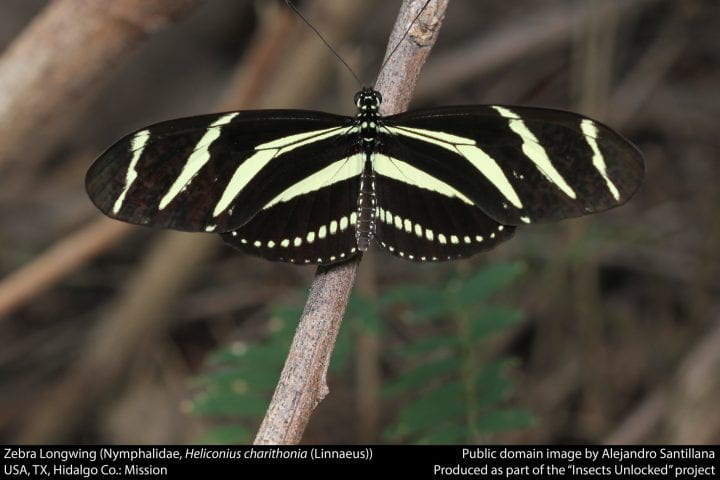UC Irvine biologists find what colors a butterfly’s world
Study identifies first known gene change in sex-differentiated vision

Irvine, Calif., Aug. 10, 2023 —As butterflies flit among flowers, they don’t all view blossoms the same way. In a phenomenon called sexually dimorphic vision, females of some butterfly species perceive ultraviolet color while the males see light and dark. University of California, Irvine biologists have discovered that in at least one species, the variation results from a vision gene’s jump onto a sex chromosome. It’s the first known finding that this kind of genetic change causes sexually dimorphic vision.
The study appears in Proceedings of the National Academy of Sciences. (Link to study: https://www.pnas.org/doi/10.1073/pnas.2301411120)
The UCI team determined this while investigating the Heliconius butterfly genus. Some of its species see ultraviolet color, an array wider than the visible light spectrum that humans perceive. A substance produced by the opsin gene accounts for these butterflies’ visual capacity. In Heliconius species with sexually dimorphic vision, ultraviolet color perception is only present in females.

In searching for the genetic mechanism behind this difference, the UCI biologists selected as their subject Heliconius charithonia, in which visual capacity is sexually dimorphic. When they finished assembling the first complete genome for this species, they learned that its W – or female – chromosome contained the opsin gene.
“This is the first known instance where dimorphic color vision in animals comes from a single gene moving to a sex chromosome,” said first author Mahul Chakraborty, an assistant project scientist in ecology and evolutionary biology. “Besides the discovery’s scientific significance, it highlights the complexities of automated genetic sequencing and the crucial role of validation.”
He did much of his work on the project while a postdoctoral researcher in the laboratories of co-corresponding authors Adriana Briscoe and J.J. Emerson, both faculty members in the Department of Ecology and Evolutionary Biology.
Previously assembled genomes for Heliconius charithonia were fragmentary. None included the W chromosome, whose highly repetitive code can pose stumbling blocks for automatic sequencing. UCI researchers began their study by automatically sequencing the species genome, but this failed to reveal all expected copies of the opsin gene. Undeterred, they next examined the coding manually.
“I went through every bit of the sequencing,” said Angelica Lara, who was an ecology and evolutionary biology undergraduate when she started working with the investigative team. Lara continued to participate in the project as a postbaccalaureate researcher after earning her degree. “I still couldn’t find the opsin after all that review. Then I realized a part of the code for the W chromosome had not been well formatted, and I believed the opsin had to be located there,” she said.
Lara’s efforts cued Chakraborty to examine that segment more closely. It turned out that the automatic sequencing had dropped that section of the chromosome’s coding, likely stymied by its repetitiveness. Restoring it revealed the opsin gene, and the team confirmed the finding with additional tests.
“Without this manual annotation and investigation, we would have made assumptions that were incorrect and misleading,” said Briscoe, professor of ecology and evolutionary biology. “Now that we’ve made this discovery, we can dig much deeper into the mechanics behind the dimorphism and understanding its purpose.”
Scientists believe the vision difference may be the reason that females and males within some butterfly species feed on different types of flowers. So far, the only other creatures known to have sexually dimorphic vision are certain kinds of primates.
The research was supported by the National Science Foundation, the National Institutes of Health, the UCI Optical Biology Core Facility and Texas A&M University startup funding.
UCI’s Brilliant Future campaign: Publicly launched on Oct. 4, 2019, the Brilliant Future campaign aims to raise awareness and support for UCI. By engaging 75,000 alumni and garnering $2 billion in philanthropic investment, UCI seeks to reach new heights of excellence in student success, health and wellness, research and more. The School of Biological Sciences plays a vital role in the success of the campaign. Learn more by visiting https://brilliantfuture.uci.edu/school-of-biological-sciences.
About the University of California, Irvine: Founded in 1965, UCI is a member of the prestigious Association of American Universities and is ranked among the nation’s top 10 public universities by U.S. News & World Report. The campus has produced five Nobel laureates and is known for its academic achievement, premier research, innovation and anteater mascot. Led by Chancellor Howard Gillman, UCI has more than 36,000 students and offers 224 degree programs. It’s located in one of the world’s safest and most economically vibrant communities and is Orange County’s second-largest employer, contributing $7 billion annually to the local economy and $8 billion statewide. For more on UCI, visit www.uci.edu.
Media access: Radio programs/stations may, for a fee, use an on-campus ISDN line to interview UCI faculty and experts, subject to availability and university approval. For more UCI news, visit news.uci.edu. Additional resources for journalists may be found at communications.uci.edu/for-journalists.